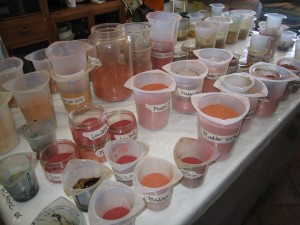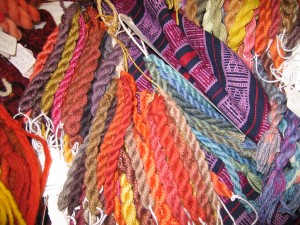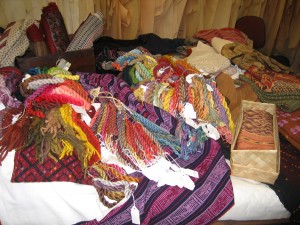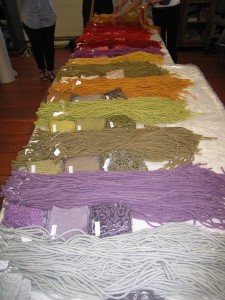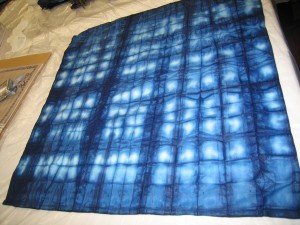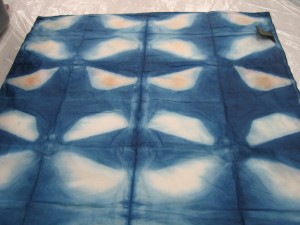Natural Dye Workshop at Maiwa East
by Elaine on Sep.27, 2009, under Blog Posts
Just got back from 4 days of dyeing with natural dyes taught by Charllotte Kwon at Maiwa East. This course is part of the Maiwa Textile Symposium for 2009, “Every thread has a story”. Sixteen people from across Canada and the state of Washington attended the workshop. Charllotte had two able assistants: Anne and Naomi, as well as help from her daughter, Sophena and son, Craig. The first day started with a slide presentation and lecture on natural dyeing with Charllotte. Then in the afternoon we split into pairs and started to mordant the yarns which had been previously scoured. We would work with cotton, linen, hemp, wool, silk, alpaca, and silk and rayon blends. Some fibres were in the form of yarns and others as fabrics. Each person had their own mordant pot and burner. At the end of the day we had mordanted all the fibres and would be ready to start the dyeing process the next morning. We mordanted with alum and tannin.
The next morning we again each had a dye pot and burner and worked in pairs and proceeded to dye all day long. The dyes included: fustic, osage sawdust, madder, lac, cochineal, cutch, logwood, marigold, henna, pomegranate, myrobalan and iron to sadden the dyes. The dyes were pre-measured and each pair was assigned the dyes and appropriate yarns/fabrics to use. Each person dyed 4 sets of dyepots and fibre. At the end of the day, we had completed 64 dyebaths.
On the third day, we sorted out the dyed samples and labelled them appropriately.
I have included a photo of the textiles that were shared with us for inspiration.
After labelling our fibres, we spent the afternoon preparing for the next day of dyeing with indigo. Anne taught us various ways to do shibori—stitching, clamping, folding, using ikat tape and thread for resist.
The last day we spent dyeing with vats of indigo. We were taught how to make the vats and the importance of how to dye in the vats without introducing alot of oxygen into the vat. Our list of dyeing was long: yarns to be overdyed; 3 unbleached cotton squares, 4 bleached cotton dinner napkins, a handwoven cotton scarf, and then some people had brought extra items. Each person had her own vat.
After exhausting our indigo vats and rinsing our fabrics, many students removed the clamps, stitching and ikat tape to see the wonderful results. Charllotte had also made some dye extracts for us to use to paint on previously mordanted skeins of wool for a direct application of dye with brushes or sponges.
It was a very full 4 days of inspiration and fun and play. I have spent the last three days since getting home from the workshop putting my book together. We were given wonderful instructions to attach the yarns and fabrics to our notebook pages. This book when I completed it this afternoon is a great reference as well as being aesthetically pleasing. It was also a great review of everything we accomplished during the workshop. I highly recommend anyone interested in natural dyeing and natural fibres to take this workshop. The inspiration is worth the price alone!
